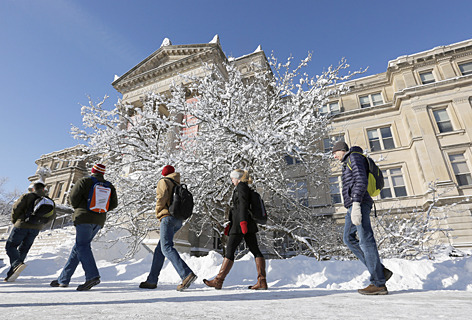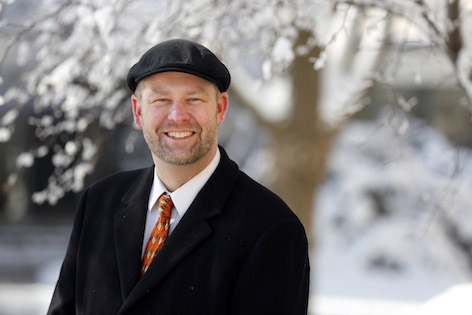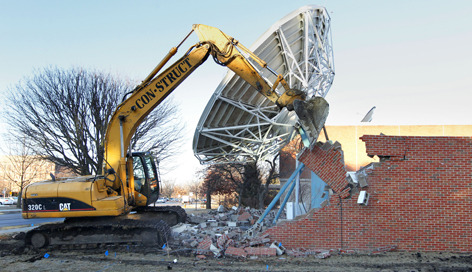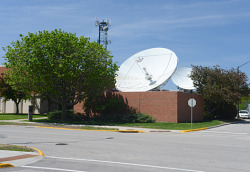Tackling the Super Bowl storm

Photo by Christopher Gannon.
When nearly a foot of snow falls on Ames, a well-rehearsed game plan is executed on campus. Here's a look at how facilities planning and management's campus services personnel tackled what the Feb. 1 Super Bowl storm left behind.
Opponent
- Roadways: 23 miles
- Sidewalks and bike paths: 34 miles
- Parking lots: 162 acres
Equipment
- 14 plows
- 4 trucks with sanders
- 14 tractors with brooms
- 19 shovelers
Supplies
- 400 pounds of ice melt
- 24 tons of salt
- 50 tons of sand
Team
- Sunday: 53 staff, working 502 hours
- Monday: 50 staff, working 536 hours
Game plan
When extreme weather doesn't permit a simultaneous offensive on all fronts, the priorities are:
- Roadways
- Parking lots
- Primary sidewalks
- Primary building entrances
- Secondary sidewalks
- Secondary building entrances
From kickoff into overtime
Work started at 5 p.m. Saturday, clearing throughways for fans at Hilton Coliseum, and continued on campus Sunday (1 a.m.-3 p.m.) and Monday (1 a.m.-4 p.m.). Sanding continued Tuesday and crews will continue to haul and push back snow this week.
Monday morning quarterback
If you see problem areas, notify FP&M by calling 294-5100. More information about winter weather policies and guidelines is available online.
Five questions for a professor from the happiest place on earth

Eric Olson, assistant professor in apparel, events and hospitality management. Photo by Christopher Gannon.
Eric Olson, assistant professor in apparel, events and hospitality management, is new to the classroom but not to events planning. Luckily for his students, Olson brings first-hand work experience, knowledge and training to his classes from his former employer, the company that has "be our guest" down to a science: Walt Disney World.
The basics
Name: Eric Olson
Position: Assistant professor in apparel, events and hospitality management
Time at ISU: Almost six months
Previous location: Sunny Florida, earning his Ph.D. from the University of Central Florida, Orlando
How did you end up at Walt Disney World and what did you do there?
After I finished my undergraduate work at the University of Wisconsin, Eau Claire, I jumped in my car and moved down to Florida. I always wanted to live in Florida, so I started working for Walt Disney World Co. and I was there for a little under six years. I absolutely loved my job there.
I had about 12 different roles or jobs. Disney is a company that is very dynamic, so you move around a lot. You're pulled for special projects here and there. I started working the frontline in attractions, either working in a theme park or a resort. Disney promotes almost completely from within, so I moved up the corporate ladder, so to speak. I spent some time in the marketing department as well, focusing on larger signature events like the Disney Marathon, the Food and Wine Festival, and the Flower Garden Festival.
So, why leave?
I always knew I wanted to be in the classroom, I just had that drive. Disney University is their training and development program. I taught a lot of classes there. I enjoyed the teaching experience. The other side of that, of course, is the research. I started playing around with some research components, and I was like, "yeah, I need to get my Ph.D. so I can get those skills to contribute to research."
Speaking of your research, you look at the impact of online reviews, especially negative ones, on businesses. Why should managers pay attention to online reviews?
Online reviews are really interesting phenomena that have impacted the service industry the last couple of years. Reviews are a way managers can get informal feedback to improve an operation. In some online review sites, like yelp.com and tripadvisor.com, managers can respond in that forum to state their side of the story, in the case of negative feedback. One of my studies showed that consumers are more likely to choose a service provider if a manager takes the time to respond. If managers show they care, and take the time to address the situation or give information about why the negative situation occurred, the consumer is more likely to respond favorably. Some smaller organizations, such as restaurants, don't have the resources or time to respond to reviews, so that's very challenging for them. My research right now is looking at what they should do. Some small businesses have hired interns to monitor online reviews. My professional opinion is that you need to have some sort of infrastructure in place that looks at online feedback. And especially in the case of negative reviews, managers need to have some sort of response.
How do you translate your Walt Disney experience for your students studying event management?
I pull from my experiences at Disney all the time within the context of the classroom. An example would be talking about the Disney training program and event production. I pull in a lot of case studies, personal examples and guest speakers through my contacts. I often connect my students to my contacts at Disney. Students enjoy hearing practical, real-world experience and they seem to respond pretty positively to that. But I always drive home the point that Disney is a public company. Their main goal is to increase shareholder wealth. Everything they do, every decision they make, keeps that goal in mind. Disney is a business.
How can smaller businesses emulate a corporate giant like Walt Disney World?
The first thing is to experience a company that provides excellent service. Another thing is paying attention to something called "servicescape," which is how the physical surroundings impact a guest. One thing you'll notice about Disney theme parks is that when you walk in, all their light bulbs are on and working and the paint on the walls is fresh. All those physical elements impact a guest's experience. Disney is fantastic about having garbage cans everywhere. The story behind that is Walt, himself, would walk through Disneyland in California eating a hot dog. When he finished the hot dog, there had to be a garbage can exactly where he was standing so he could throw his wrapper away. Those kinds of little things that Disney does are things that other companies can pick up, too.
Sunset on ISU strategic plan extended six months
Iowa State's current five-year strategic plan, "Meeting the Challenges of the 21st Century," will extend into a sixth year. In a Jan. 20 memo to his three senior vice presidents, President Steven Leath shared his intent to use the plan for six months past its scheduled expiration date at the end of this calendar year. It will remain in place through June 30, 2016.
Leath noted several reasons for his decision:
- Later this year, the state Board of Regents will begin its own strategic planning process. Delaying the start of the university planning process will allow Iowa State's strategic plan to address board priorities.
- Aligning the strategic plan with the fiscal year – which begins on July 1 -- rather than the calendar year better connects annual budget strategies to broader plans.
- The extra months provide time and opportunity to involve more stakeholders in the process of developing the next strategic plan.
- Iowa State continues to make progress on each of the four priorities in the current strategic plan, which focuses on fulfilling the university's land-grant responsibilities.
The process
Leath said that by fall he will provide his long-term vision for Iowa State, which will become a guide for developing the next strategic plan. His goal, he wrote, is that the next strategic plan will be presented to him no later than May 1, 2016.
"Iowa State University has tremendous opportunities," Leath wrote, "and I look forward to developing a plan that helps us strategically focus our resources in areas that make an enduring impact for our state, nation and world."
So long, satellite

Photo by Christopher Gannon.
The north side of campus lost one if its directional landmarks last week when the enormous satellite dish near the Communications Building was dismantled. It was one of two satellite dishes removed from the northwest corner of the Pammel Drive intersection with WOI Road.
The largest one, enclosed by a brick wall and chain-link fence, was constructed in 1985. It was the first "permanent video satellite earth station" built in Iowa. It cost nearly $600,000 -- purchased with WOI-TV operating funds and commercial revenues generated through video uplinks. Iowa State used the satellite for university and extension programs, including course delivery and continuing education.

The satellites prior to their removal. File photo by Bob Elbert.
As part of a collaboration of universities, Iowa State provided space just north of the WOI device for an additional satellite in 1987. Purchased by National Technological University, the second satellite was utilized for engineering-based continuing and graduate education.
Jim Haberichter, construction manager in facilities planning and management and project manager, said the satellites, enclosure, control building and electronics are being salvaged and recycled. He said both satellites used analog transmissions, rather than digital, and were no longer used.
When weather permits, the sidewalk on the east side of the Communications Building will be extended south to Pammel Drive and landscaping will be added. Pedestrians should continue to cross Pammel at the northeast corner (Molecular Biology Building) of the intersection for safety reasons.
Paper, food container recycling needs new service provider
The unanticipated loss last week of a recycling vendor has facilities planning and management leaders in a jam to find a new vendor while not interrupting several recycling services to campus buildings.
Ames Area Redemption Center, which closed last week, notified FPM on Jan. 27 that its last pickups from campus buildings would be Jan. 30. The east Ames recycling center has provided building pickup of mixed paper, white paper, newspaper and food/beverage containers for Iowa State since July 2013. Mixed paper and food/beverage container recycling became available for the first time on campus because of that contract.
Facilities services director Bob Currie said it's likely Iowa State will rebid this recycling contract, a process that could take up to two months. FPM and purchasing leaders inquired with another ISU vendor about adding this recycling service to its ISU contract, but those discussions ended Wednesday without an agreement.
Cardboard recycling and confidential document destruction are handled by other vendors and are not affected by this change.
Thank you, campus services
On Monday (Feb. 2), campus services crews assumed the recycling pickup schedule for academic buildings. However, this group's duties also include snow removal across campus, and Currie noted that Sunday's 12-inch snowfall has limited the time crews could give to emptying recycling bins this week.
"We're trying to fill this gap with our own staff, so we hope people can be understanding if we miss a building or pick up a day late, particularly if there's more snow," Currie said. Once employees are habitual recyclers, it's critical to avoid any big interruptions to the service, he noted.
Interim plan
Currie said ISU employees should continue to recycle the four categories – mixed paper, white paper, newspaper and food/beverage containers – as they have, using the lidded blue recycling containers in their buildings. In the interim, materials are being mixed, so all recyclables (except cardboard and confidential documents) can be placed in any recycling container, whether it's labeled for that item or not.
Campus services crews will transfer recyclables from building containers to a single Waste Management recycling dumpster on campus. Waste Management will recycle the materials.
Softball opens season indoors
Softballs replace pigskins this weekend at the Bergstrom Football Complex, when the Iowa State softball team hosts Utah State and South Dakota State for its annual indoor Cyclone Invitational. Home plate is situated in the southeast corner of the artificial turf, with a regulation right field fence (190 feet) and shortened outfields in center and left.
Admission is free. Seating is available outside the right field fence, but fans must provide their own blankets and lawn chairs. Enter at the north door of the complex (signs will mark the entrance). Limited concessions will be available. The temperature in the facility varies with occupancy, but does not drop below 55.
Cyclone Invitational schedule
Friday, Feb. 6
- 5:30 p.m., Iowa State vs. Utah State
Saturday, Feb. 7
- 9:30 a.m., Utah State vs. South Dakota State
- Noon, Iowa State vs. Utah State
- 2:30 pm., Iowa State vs. South Dakota State
Sunday, Feb. 8
- 9 a.m., South Dakota State vs. Utah State
- 11:30 a.m., Iowa State vs. South Dakota State
